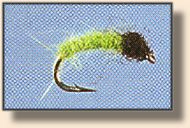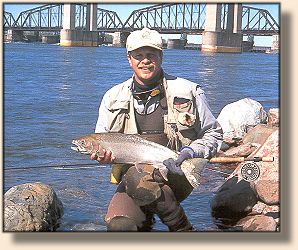Flies for Steelhead
Lake Huron and Georgian Bay Streams
By Scott E. Smith
Because of the span in latitude between Lake Huron's most northern
and southern streams, the timing of steelhead and salmon runs
cannot be generalized more specifically . . .But similarly, the
traveling angler can follow the steelhead runs from the earliest
fish in the Nottawasago and Saugeen in March, to the latest in the
St. Mary's at the end of May and beginning of June, and enjoy a
long stint of steelhead fishing in both spring and fall. The only
limiting factors in these seasonal endeavours will be your pocket
book, your employer, and in some cases your spouse. (All of which
must be factored into your timing plans unless you are willing
to deal with the consequences.) Also unlike Superior streams, which
are blessed with a virtual open season for steelhead and salmon in
most streams (excepting December 25), open season regulations vary
from stream to stream in Huron's drainage.
Fly Patterns
 Generically speaking, caddis larvae are a good bet almost any
time on Huron streams for steelhead and salmon. If there is
one fly that you should carry in volumes, and in various shades
and sizes, it is the Olive Caddis Larvae Nymph. A simple but very
effective pattern is created with just two basic ingredients: dubbed
olive hare's mask fur for the body, and a peacock hurl thorax. The
best hook for the job is a curved, heavy scud hook, such as the TMC
2457 or Daiichi 1150; these are sharp and very strong hooks - necessary
ingredients for any steelhead and salmon fly. Tie this simple pattern
in sizes 14 through 8 in various shades of olive and green, and even
in bright chartreuse. Substituting ostrich hurl or hare's mask
dubbing tied loosely for the thorax material will give greater variety.
If you simply cannot tie such a basic pattern without being overly
technical (those of you who are sometimes referred to as techno
weenies by your friends), rib the abdomen with gold wire, or even
net some samples from your favorite stream to copy if you desire.
I have found some suprisingly bright-coloured caddis larvae under
rocks, and yes, even in the bellies of trout (old habits die hard).
Generically speaking, caddis larvae are a good bet almost any
time on Huron streams for steelhead and salmon. If there is
one fly that you should carry in volumes, and in various shades
and sizes, it is the Olive Caddis Larvae Nymph. A simple but very
effective pattern is created with just two basic ingredients: dubbed
olive hare's mask fur for the body, and a peacock hurl thorax. The
best hook for the job is a curved, heavy scud hook, such as the TMC
2457 or Daiichi 1150; these are sharp and very strong hooks - necessary
ingredients for any steelhead and salmon fly. Tie this simple pattern
in sizes 14 through 8 in various shades of olive and green, and even
in bright chartreuse. Substituting ostrich hurl or hare's mask
dubbing tied loosely for the thorax material will give greater variety.
If you simply cannot tie such a basic pattern without being overly
technical (those of you who are sometimes referred to as techno
weenies by your friends), rib the abdomen with gold wire, or even
net some samples from your favorite stream to copy if you desire.
I have found some suprisingly bright-coloured caddis larvae under
rocks, and yes, even in the bellies of trout (old habits die hard).
The Gold Ribbed Hare's Nymph, and the multitude of variations of same,
are also very important for this fishery. A good adaptation of this
fly as tied by Michigan writer Bob Linsenman, is a Hare's Ear Nymph
tied with olive hare's mask dubbing for the abdomen and thorax,
and gray filoplume for the tail. Bob claims that the filoplume
tail undulated nicely to represent the swimming motions of many
mayfly nymphs. Hexagenia nymphs are also important
in many of the streams with dams, reservoirs and other areas with
silty bottoms.
Stoneflies are always a good pattern for steelhead in freestone
sections of streams, and are particularly effective in early
spring when the first steelhead enter Huron's tributaries. Tie
general stonefly imitations in a variety of sizes and shades of
brown and black.
 It is important to remember that the nymphs of all species of
aquatic insects live in the stream for several years (in the
case of some stoneflies up to three years), and hence they are
present in a variety of sizes in the stream. To express this
in simpler terms, this means that just because you are fishing
a stream in April where a giant salmonfly hatch occurs in June,
doesn't mean that you should be fishing a three-inch-long
nymph, even though the adult is that size when it hatches. The
predominant size of salmonfly nymphs in that stream at that
particular time may be a one-inch-long specimen. Subsequently
you need to carry your favourite nymph patterns in a variety
of sizes.
It is important to remember that the nymphs of all species of
aquatic insects live in the stream for several years (in the
case of some stoneflies up to three years), and hence they are
present in a variety of sizes in the stream. To express this
in simpler terms, this means that just because you are fishing
a stream in April where a giant salmonfly hatch occurs in June,
doesn't mean that you should be fishing a three-inch-long
nymph, even though the adult is that size when it hatches. The
predominant size of salmonfly nymphs in that stream at that
particular time may be a one-inch-long specimen. Subsequently
you need to carry your favourite nymph patterns in a variety
of sizes.
Although dry-fly fishing for steelhead and salmon in Ontario
is a new venture, there is a small subculture of anglers that
are actively pursuing this endeavour. Steelhead anglers in
many streams, particularly in warmer periods of both the spring
and fall runs, are taking fish on both dead-drifted traditional
ties and waking or Bomber patterns. There is room here for
many pioneers and adventurous souls. What you need to know
is that Huron steelhead will take a dry fly, so keep some
dries in your box during the run.
Streamers are also useful in these moderate periods during
late spring and early fall. Spawned-out steelhead in the
spring are particularily ravenous in the large tributaries where
the return to the lake may involve traversing fifty or more
kilometers of stream. Fall steelhead and salmon are also
interested in streamer patterns; particularly fall steelhead,
which are feeding heavily on salmon eggs and salmon carrion.
Other species that spawn in the fall will also smash a bright
or gaudy streamer out of aggression, especially male brown trout,
Chinook and coho salmon. Good streamers for Huron streams
include the Woolly Bugger, Muddler Minnow, Marabou Matuka,
Zonker, Strip Leech and a number of West Coast steelhead
patterns, such as the Skykomish Sunrise, the Polar Shrimp
and the Fall Favorite. ~ Scott E. Smith
Credits: From Ontario Blue-Ribbon Fly Fishing Guide
by Scott E. Smith. We thank
Frank Amato Publications, Inc. for use permission!
Our Man In Canada Archives
|

